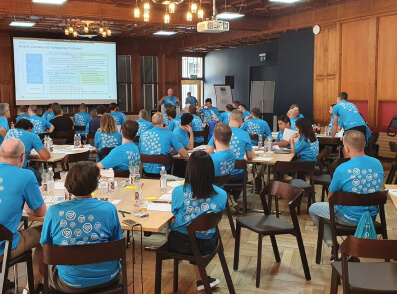Key takeaways
- Banks need to shift from a transactional to a relational model, becoming daily lifestyle partners to inspire loyalty.
- Digital wellness strategies provide a powerful blueprint for this new engagement model, using gamification, nudges, and personalization.
- Healthier customers are better financial customers, as their improved well-being leads to more focused and disciplined financial decisions.
- Wellness programs give banks a reason to connect with customers daily, moving beyond financial transactions to build stronger relationships.
- Research from leading firms proves a direct link between strong customer engagement, well-being, and a bank’s bottom line—including higher revenue and reduced attrition.
- dacadoo’s DHEP is a proven solution that can be adapted to help banks smoothly combine financial and health engagement in a single ecosystem.
The engagement challenge in banking
In the good old days, the bank you used was probably the one your parents set up for you when you were a child. This was due to a number of factors, including limited banking options and the convenience of staying with a familiar institution. The digital arena has fundamentally changed all this, however.
The rapid growth of automated services and the resultant decline in branch visits has created a major engagement deficit for banks. To a new generation of consumers, banks can feel like faceless utilities that are differentiated merely by fees or interest rates. To counteract this, banks need to develop new daily touchpoints with their customers to create a relational—not just transactional—bond.
Health is wealth: Why banks should increase touchpoints with health & wellness strategies

The connection between health and financial wellness is far more profound than it initially appears. The two are deeply intertwined, in fact, with one often influencing the other.
Healthier customers make better financial decisions. A recent McKinsey report on employee health highlights that a focus on well-being can improve productivity and presenteeism, reducing stress-driven mistakes and poor decision-making. When individuals are mentally sharper and less stressed, they are more likely to make rational, long-term financial choices.
Reduced healthcare spending leads to more disposable income. In many markets, particularly the U.S., a major portion of a household’s budget is allocated to healthcare. By helping customers improve their well-being, banks can indirectly contribute to lower healthcare spending. This frees up disposable income, which can then be used for savings, investments, or other financial products—creating new business opportunities for the bank.
Daily engagement beyond transactions. A bank’s app is traditionally used for functional purposes. Integrating wellness principles allows banks to create new, non-financial reasons for customers to interact with their app daily. These features create a new kind of relationship, positioning the bank as a daily companion on the customer’s health journey, not just a service provider.
Lessons from digital health engagement
Fortunately, banks don’t have to invent a new engagement model from scratch. The digital health and wellness sector has spent years perfecting a model for high-frequency, highly personalized engagement.
Platforms like dacadoo’s Digital Health Engagement Platform (DHEP) use gamification to turn mundane activities like walking or tracking sleep into a more engaging and rewarding experience. Setting daily, weekly, or monthly challenges—along with nudges that serve as highly personalized reminders—we encourage small but consistent habit changes.
It’s an approach that’s proven remarkably effective. A study from the University of Groningen found that DHEP led to a 4.9% reduction in healthcare costs in the first year, rising to a 5.3% reduction in the second year. The key to this success was not the intensity of use but the frequency of use, demonstrating that consistent, daily engagement drives meaningful, long-term behavior change.
Incorporating dacadoo’s DHEP turns a banking app into a trusted, daily companion that helps customers achieve both their financial and health goals. Most importantly, it’s a strategy that builds loyalty not by focusing on low fees, but by providing continuous, personalized value.
Applying engagement to banking
Aside from the engagement that incorporating health and wellness platforms like dacadoo offer, banks can apply the same principles used in digital health to financial services.
Personalized financial journeys: Instead of generic savings tips, banks can use data to create personalized budgeting, savings, and debt-reduction journeys. This could be a gamified challenge to “Save $500 in 60 days” with a personalized savings goal and virtual rewards for hitting milestones.
Rewards and loyalty programs: Loyalty points can be tied not just to spending, but to proactive financial health. A customer who consistently uses their savings tool or completes a financial literacy module could earn higher rewards or better interest rates.
Cross-industry partnerships: Banks can expand their value proposition by partnering with the broader health and wellness ecosystem. Collaborating with fitness apps, health insurers, or even healthy food retailers could unlock new loyalty programs and co-branded challenges. A partnership with a health insurer, for example, could offer members a discount on their premiums for maintaining a high financial wellness score.
Benefits for banks
The advantages of implementing engagement strategies of this kind can be profound.
Increased daily app use: Creating engaging, non-financial content gives customers a reason to open their banking app every day, solidifying its place as a core part of their daily routine.
Improved cross-sell and upsell opportunities: With a deeper understanding of a customer’s lifestyle and a more engaged relationship, banks can offer more relevant products at the right time.
Stronger brand loyalty and differentiation: When a bank is viewed as a partner in a customer’s overall well-being—not just their financial health—it builds a powerful and defensible brand identity. This kind of loyalty is far more resilient to price-based competition.
Future trends
Personalization may be the current focus of industries across the board, however, AI is going to take this to an entirely new level of tailored advice and recommendations. This “hyper-personalization” will deliver functionality such as gamified loyalty programs that are precisely aimed at an individual, based on their aspirations, habits, and capabilities.
Within this, banks will expand their definition of “financial wellness” to include broader health and lifestyle decisions that are designed to fit each and every one of their customers perfectly. In short, banks won’t just help you to look after your money, they’ll help you to look after you.
A forward-looking partnership with dacadoo

dacadoo’s Digital Health Engagement Platform (DHEP) offers banks a proven way to improve customer health—a natural path to increased customer engagement and loyalty. With our flexible platform easily adapted to the demands of the retail banking sector, we offer forward-thinking banks a quick and effective way to build a next-generation engagement strategy.
With dacadoo in your corner, a bank can escape the confines that the digital arena has placed on customer engagement and become a true and meaningful partner in your customers’ overall wellness and lifestyle. To find out more about dacadoo’s Digital Health Engagement Platform (DHEP) and how it can help your bank thrive, you can contact us here.






















